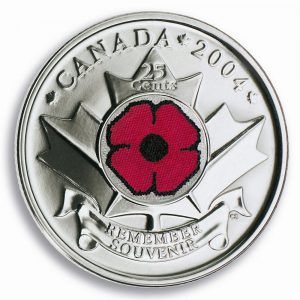In July 1921, the Canadian Great War Veterans Association (CGWVA) – now the Royal Canadian Legion – officially recognized the poppy as a symbol of remembrance.
Inspired by John McCrae’s poem “In Flanders Fields,” Madame Anna Guérin, of France, began to popularize the Remembrance Day poppy a year earlier to raise money for war-torn regions of her home country. Through the British Legion, she organized the commission of a million fabric poppies, all of which were sold before another eight million were commissioned. Her fundraising idea was later considered and approved at a CGWVA meeting in Port Arthur, Ont. (now Thunder Bay).

A 25-cent poppy coin – the Mint’s first – was named the ‘Most Innovative Circulation Coin’ at the 2004 Mint Directors’ Conference in France.
A century later, as part of the country’s “Poppy 100” celebrations, both a commemorative coin from Royal Canadian Mint and a stamp from Canada Post are in the works.
This year, the Legion will also mark the poppy’s centennial with commemorative pins replicating the original 1921 lapel pin plus a special video highlighting the poppy’s history.
Several national landmarks, including the CN Tower, the Calgary Tower and BC Place, were lit on July 6 to mark the 100th anniversary.
The Mint has issued coins to mark Remembrance Day since 2004, when it struck its first 25-cent poppy coin.

